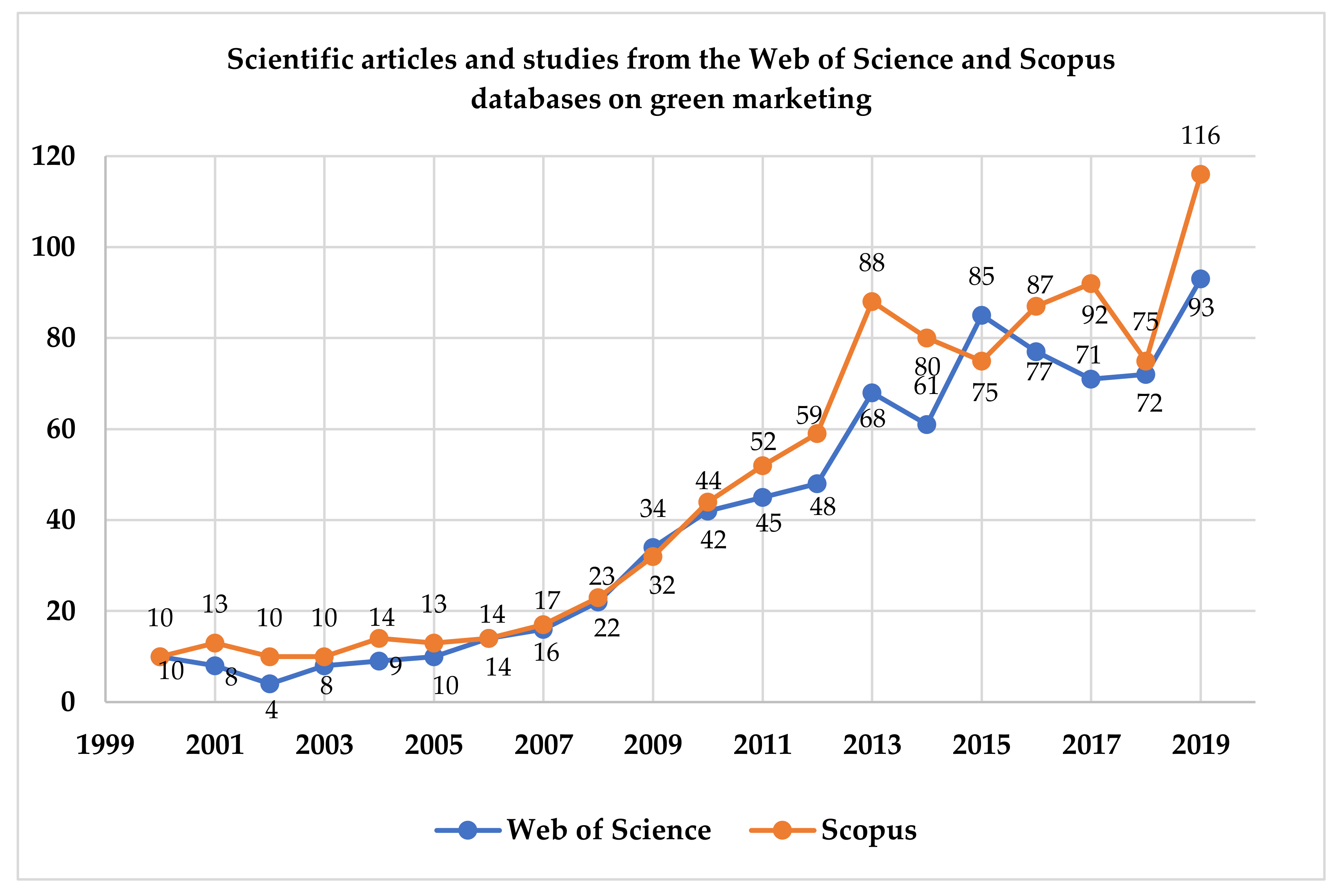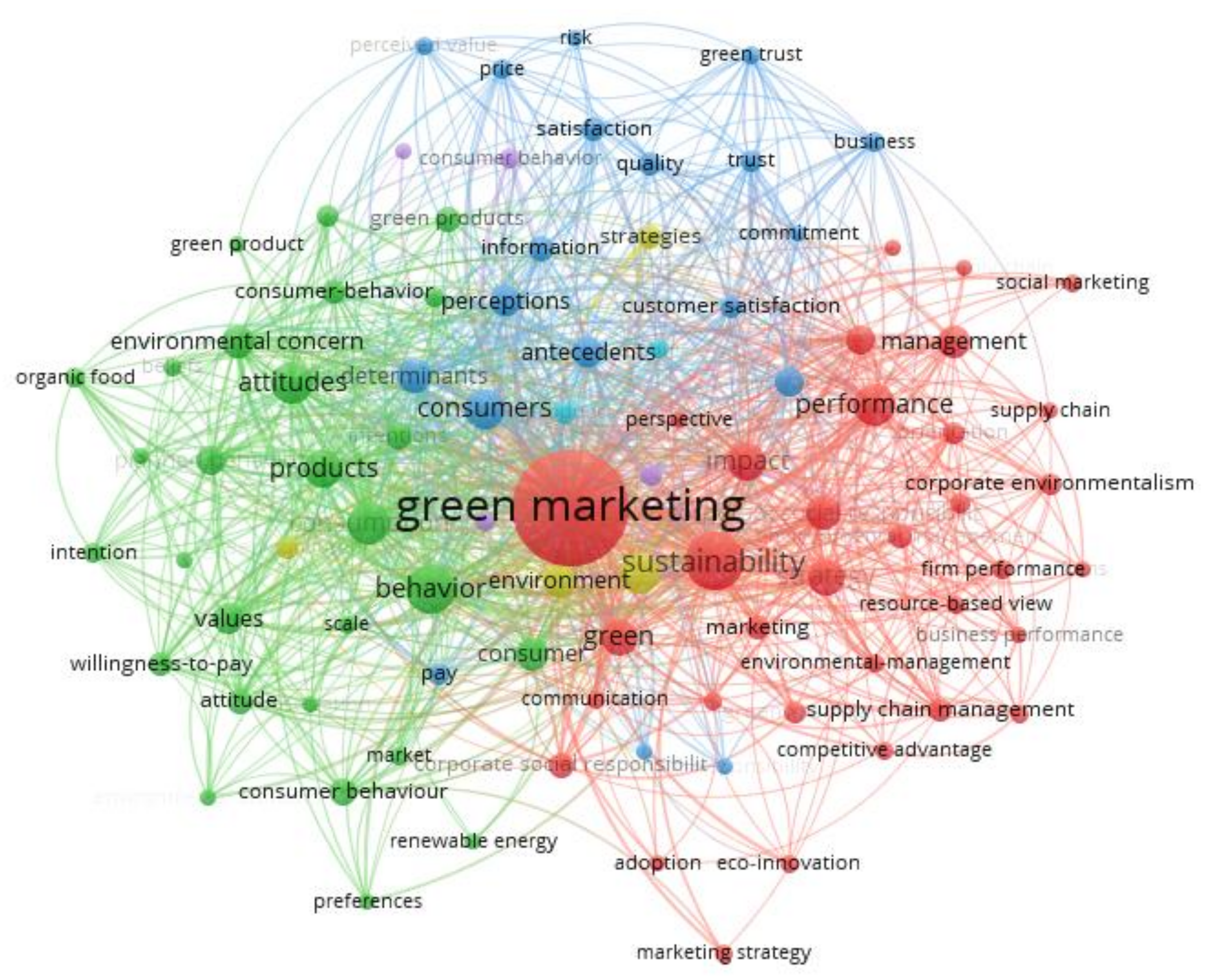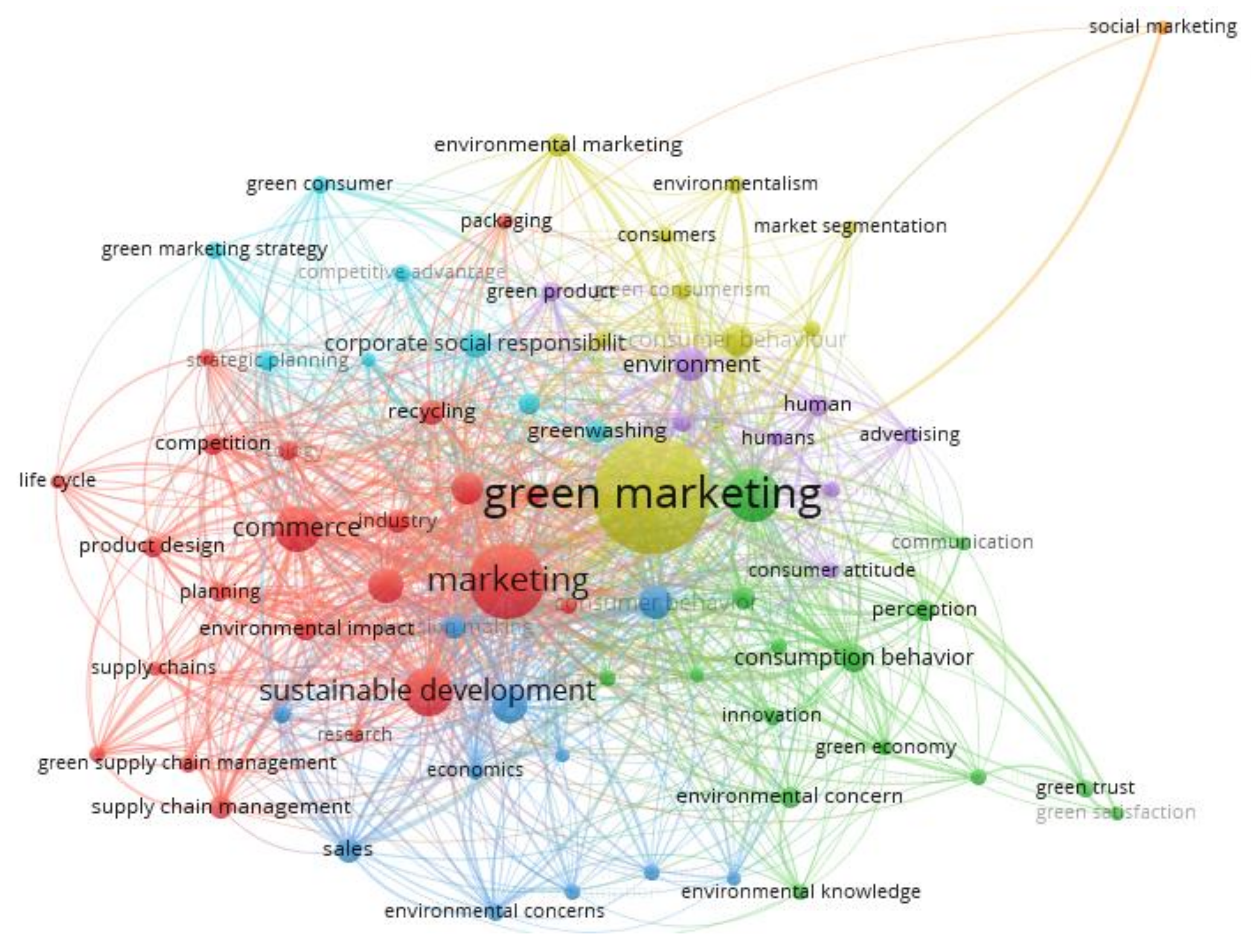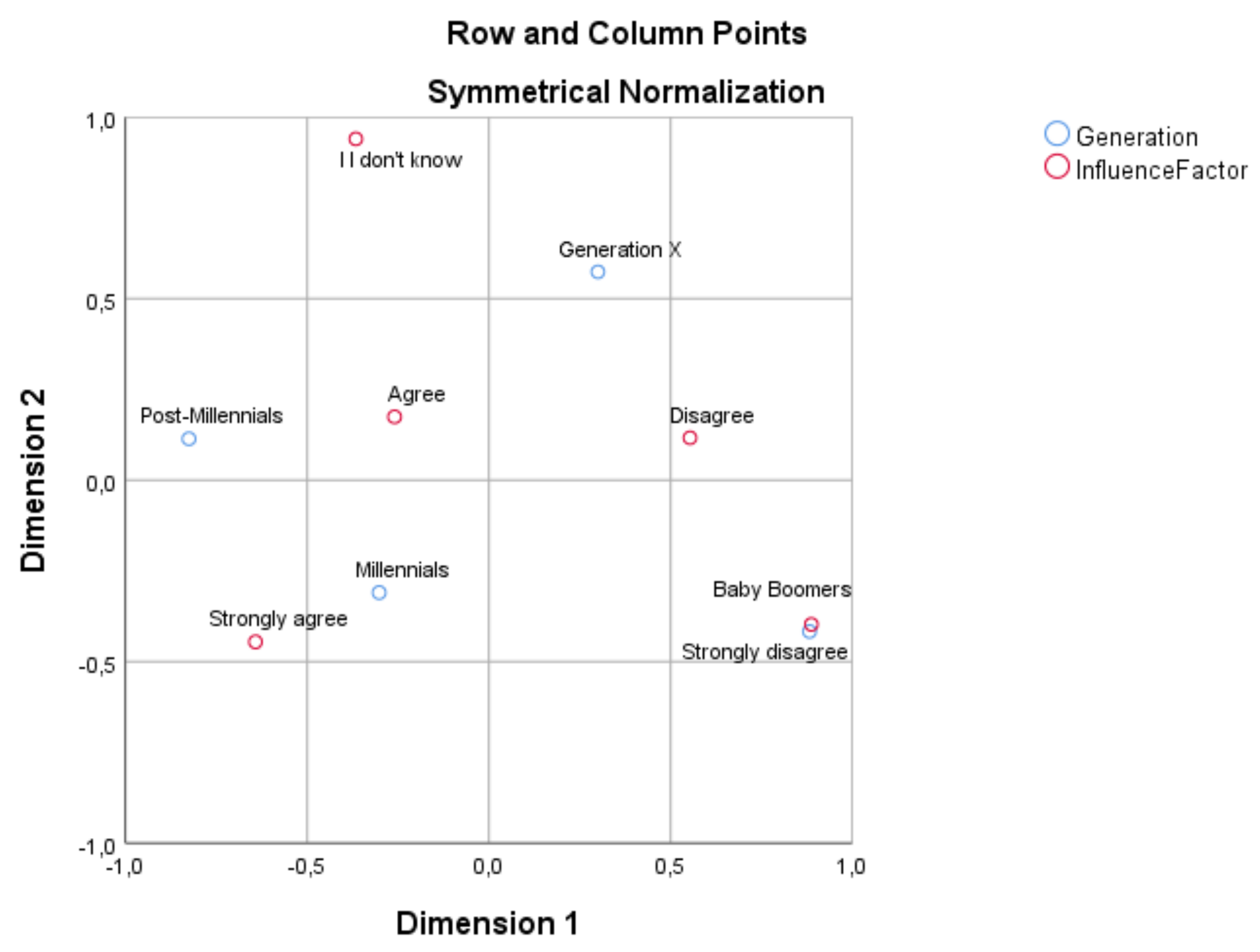Green Marketing as a Part of the Socially Responsible Brand’s Communication from the Aspect of Generational Stratification
Abstract
1. Introduction
- Silent (born 1928–1945)
- Boomers (born 1946–1964)
- Generation X (1965–1980)
- Millennials (born 1981–1996)
- Postmillennials/Generation Z (born 1997–2012)
- Unknown (2012–present) [30].
- Baby Boomers (1946–1964) are related to post-war population expansion and represent the most numerous generation among the generations recorded so far.
- Generation X (1965–1980) is also referred to as the so-called Baby Busters, Post Boomers, or Slackers.
- Millennials (1981–1996) also known as Generation Y, Generation Next, Digital Generation, Nexters, Echo Boomers, Google Generation, or the Why Generation, is currently the most numerous generation [35].
- Post-Millennials (1997–2009) are also referred to as Generation Z, Zeds, Zees, Bubble Wrap Kids, The New Millennials, Digital Natives, Wired Generation, Screenagers, or iGen [36].
- Hypothesis 1 (H1).When making purchasing decisions, 50% of Slovak consumers prefer a brand that behaves ecologically (applies the principles of green marketing).
- Hypothesis 2 (H2).More than 50% of Baby Boomers consider the application of green marketing as a part of the socially responsible brand’s communication to be a factor in increasing brand value.
- Hypothesis 3 (H3).Hypothesis 3: More than 50% of consumers in Generation X consider the application of green marketing as a part of the socially responsible brand’s communication to be a factor in increasing brand value.
- Hypothesis 4 (H4).More than 50% of Millennials consider the application of green marketing as a part of the socially responsible brand’s communication to be a factor in increasing brand value.
- Hypothesis 5 (H5).More than 50% of Post-Millennials consider the application of green marketing as a part of the socially responsible brand’s communication to be a factor in increasing brand value.
- Hypothesis 6 (H6).There is statistically significant dependence between the age of Slovak consumers (membership of a generational cohort) and their perception of a brand’s usage of green marketing principles as an important factor in purchasing decisions.
2. Materials and Methods
3. Results
3.1. Results of the Bibliometric Analysis
3.2. Results of Questionnaire Survey Focused on the Perception of the Green Marketing as a Part of the Socially Responsible Brand’s Communication from the Aspect of Generational Stratification
3.3. Verification of Statistical Hypotheses
Hypothesis 6
4. Discussion
- A focus on innovative products,
- A preference of environmental properties of products,
- A willingness to pay more for a higher-quality product, such as a product with environmental properties,
- A medium recycling rate, saving energy resources,
- A willingness to participate in environmental projects,
- A positive relationship and preference for digital media (internet advertising, websites, email marketing, social networks, blogs, and podcasts) as a socially responsible communication tool.
- brand orientation, strong brand loyalty,
- a preference for online product ordering,
- an interest in the environmental properties of products,
- a lower willingness to pay more for a product with environmental characteristics,
- interest and knowledge about the environment,
- fear of environmental pollution,
- a medium recycling rate,
- a willingness to participate in environmental projects,
- preferring communication via digital media (social networks, blogs and podcasts, discussion forums, mobile applications, influencer marketing, etc.).
5. Conclusions
Author Contributions
Funding
Acknowledgments
Conflicts of Interest
References
- Gregova, E.; Kramarova, K.; Dengov, V.V. Signifinance of the Corporate Social Responsibility at National and International Level. In Proceedings of the International Conference on Information and Business Management, Hong Kong, China, 3–4 September 2016; pp. 9–15. [Google Scholar]
- Moravcikova, D.; Krizanova, A.; Kliestikova, J.; Rypakova, M. Green Marketing as the Source of the Competitive Advantage of the Business. Sustainability 2017, 9, 2218. [Google Scholar] [CrossRef]
- Sroka, W.; Szanto, R. Corporate Social Responsibility and Business Ethics in Controversial Sectors: Analysis of Research Results. J. Entrep. Manag. Innov. 2018, 14, 111–126. [Google Scholar] [CrossRef]
- Stonkute, E.; Vveinhardt, J.; Sroka, W. Training the CSR Sensitive Mind-Set: The Integration of CSR into the Training of Business Administration Professionals. Sustainability 2018, 10, 754. [Google Scholar] [CrossRef]
- Prosenak, D.; Mulej, M.; Snoj, B. A requisitely holistic approach to marketing in terms of social well-being. Kybernetes 2008, 37, 1508–1529. [Google Scholar] [CrossRef]
- Polonsky, J. An Introduction to Green Marketing. Electron. Green J. 1994, 1, 1–10. [Google Scholar] [CrossRef]
- Henion, K.E.; Kinnear, T.C. Ecological Marketing; American Marketing Association: Chicago, IL, USA, 1976; pp. 1–2. [Google Scholar]
- Menon, A.; Menon, A. Enviropreneurial marketing strategy: The emergence of corporate environmentalism as market strategy. J. Mark. 1997, 61, 51–67. [Google Scholar] [CrossRef]
- McDaniel, S.W.; Rylander, D.H. Strategic green marketing. J. Consum. Mark. 1993, 10, 4–10. [Google Scholar] [CrossRef]
- Baker, M.J. The Marketing Book, 5th ed.; Butterworth–Heinemann: Burlington, MA, USA, 2003; p. 727. [Google Scholar]
- Juraskova, O.; Hornak, P. Velký Slovník Marketingových Komunikací; Grada Publishing: Praha, Czech Republic, 2012; p. 82. [Google Scholar]
- White, K.; MacDonnell, R.; Dahl, D.W. It’s the mind-set that matters: The role of construal level and message framing in influencing consumer efficacy and conservation behaviors. J. Mark. Res. 2011, 48, 472–485. [Google Scholar] [CrossRef]
- American Marketing Association. Available online: http://www.marketingpower.com/_layouts/dictionary.aspx (accessed on 25 February 2020).
- Grant, J. The Green Marketing Manifesto; John Wiley & Sons: Chichester, West Sussex, UK, 2007; 320p. [Google Scholar]
- Kicova, E.; Krizanova, A. Building a sustainable brand. In Springer Proceedings in Business and Economics: Advances in Applied Economic Research; Tsounis, N., Vlachvei, A., Eds.; Springer International Publishing: Cham, Switzerland, 2017; pp. 367–379. [Google Scholar]
- Kliestikova, J.; Kovacova, M.; Krizanova, A. Brand value sources: Case study of bank brands in Slovak republic. In Proceedings of the 39th International Scientific Conference Economic and Social Development—Sustainability from an Economic and Social perspective, Lisbon, Portugal, 29–30 April 2019; pp. 361–368. [Google Scholar]
- Stuchly, J.; Jambal, T.; Lizbetinova, L. Loyalty Programs and Customer Preferences. In Proceedings of the 32nd Conference of the International Business Information Management Association—Vision 2020: Sustainable Economic Development and Application of Innovation Management, Seville, Spain, 15–16 November 2018; pp. 8321–8328. [Google Scholar]
- Howe, N.; Strauss, W. The Next 20 Years: How Customer and Workforce Attitudes Will Evolve. Harv. Bus. Rev. 2007, 85, 41–52. [Google Scholar]
- Tolbize, A. Generational Differences in the Workplace; University of Minnesota: Minneapolis, MN, USA, 2008; p. 25. [Google Scholar]
- Troll, L.E. Issues in the study of generations. Aging Hum. Dev. 1970, 1, 199–218. [Google Scholar] [CrossRef]
- Nazareth, L. The Leisure Economy: How Changing Demographics, Economics, and Generational Attitudes Will Reshape Our Lives and Our Industries; John Wiley & Sons: Toronto, ON, Canada, 2007; p. 288. [Google Scholar]
- Taylor, P. The Next America: Boomers, Millennials, and the Looming Generational Showdown; Hachette UK: London, UK, 2016; p. 384. [Google Scholar]
- Kim, N.; Srivastava, R.K.; Han, J.K. Consumer decision-making in a multi-generational choice set context. J. Bus. Res. 2001, 53, 123–136. [Google Scholar] [CrossRef]
- Keyser, H. How Do Generations Get Their Names? Available online: http://mentalfloss.com/article/59963/how-do-generations-get-their-names (accessed on 20 February 2020).
- Reeves, T.C.; Oh, E. Generation Differences. In Handbook of Research on Educational Communications and Technology; Lawrence Erlbaum Associates: New York, NY, USA, 2008; pp. 295–303. [Google Scholar]
- Raphaelson, S. From GIs to Gen Z (Or Is It iGen?): How Generations Get Nicknames. Available online: https://www.npr.org/2014/10/06/349316543/don-t-label-me-origins-of-generational-names-and-why-we-use-them?t=1529763974286 (accessed on 20 February 2020).
- WJSchroer. Generations X, Y, Z and the Others. Available online: http://socialmarketing.org/archives/generations-xy-z-and-the-others/ (accessed on 20 February 2020).
- Bromwich, J.E. Tell Us What to Call the Generation after Millennials (Please). Available online: https://www.nytimes.com/2018/01/23/style/generationnames.html?action=click&module=RelatedCoverage&pgtype=Article®ion=Footer (accessed on 21 February 2020).
- Bromwich, J.E. We Asked Generation Z to Pick a Name. It Wasn’t Generation, Z. Available online: https://www.nytimes.com/2018/01/31/style/generation-z-name.html (accessed on 21 February 2020).
- Loria, K.; Lee, S. Here’s Which Generation You’re Part of Based on Your Birth Year—and Why Those Distinctions Exist. Available online: http://www.businessinsider.com/generation-you-are-in-by-birth-year-millennial-gen-x-baby-boomer-2018-3 (accessed on 23 February 2020).
- Kim, S. Managing millennials’ personal use of technology at work. Bus. Horiz. 2018, 61, 261–270. [Google Scholar] [CrossRef]
- Au-Yong-Oliveira, M.; Goncalves, R.; Martins, J.; Branco, F. The social impact of technology on millennials and consequences for higher education and leadership. Telemat. Inform. 2018, 35, 954–963. [Google Scholar] [CrossRef]
- Chicca, J.; Shellenbarger, T. Connecting with Generation Z: Approaches in Nursing Education. Teach. Learn. Nurs. 2018, 13, 180–184. [Google Scholar] [CrossRef]
- McCrindle, M. The ABC of XYZ: Understanding the Global Generations; McCrindle Research: Bella Vista, AR, USA, 2014; p. 288. [Google Scholar]
- Fry, R. Millennials are the Largest Generation in the U.S. Labor Force. Available online: http://www.pewresearch.org/fact-tank/2018/04/11/millennials-largest-generation-us-labor-force/ (accessed on 1 March 2020).
- Dimock, M. Defining Generations: Where Millennials End and Post-Millennials Begin. Available online: http://www.pewresearch.org/fact-tank/2018/03/01/defining-generations-where-millennials-end-and-post-millennials-begin/ (accessed on 1 March 2020).
- Arıker, Ç.; Toksoy, A. Generation Z and CSR: Antecedents of purchasing ıntention of university students. KAUJEASF 2017, 8, 483–502. [Google Scholar] [CrossRef]
- Van den Bergh, J.; Behrer, M. How Cool Brands Stay Hot: Branding to Generations Y and Z; Kogan Page: London, UK, 2016; p. 312. [Google Scholar]
- Nielsen. The Sustainability Imperative. Available online: https://www.nielsen.com/us/en/insights/report/2015/the-sustainability-imperative-2/# (accessed on 29 May 2020).
- Sourcing Journal. What Millennials and Gen Z Think of Your Brand’s CSR Efforts, and What You Can Do about It. Available online: https://sourcingjournal.com/topics/sustainability/qima-social-environmental-issues-165663/ (accessed on 29 May 2020).
- Lumesse. Corporate Social Responsibility is a Key in Attracting Millennials. Available online: https://www.greenbeanrpo.com/wp-content/uploads/2018/02/corporate_social_responsiblity_attracting_millenials_white_paper.pdf (accessed on 29 May 2020).
- Lazarevic, V. Encouraging brand loyalty in fickle generation Y consumers. Young Consum. 2012, 13, 45–61. [Google Scholar] [CrossRef]
- Vilela, A.M.; Nelson, M.R. Testing the selectivity hypothesis in cause-related marketing among generation y: [When] does gender gatter for short- and long-term persuasion? J. Mark. Commun. 2016, 22, 1–18. [Google Scholar] [CrossRef]
- Nga, J.K.H.; Soo, N.W.M. A study on the factors influencing the perception of ethical branding among generation y consumers in Malaysia. AFBE J. 2013, 6, 40–62. [Google Scholar]
- Yoon, J.M.; Littrel, M.A.; Niehm, L. Young female consumers’ intentions toward fair trade consumption. Int. J. Retail Distrib. Manag. 2012, 40, 41–63. [Google Scholar]
- Kim, H.S. A reputational approach examining publics’ attributions on corporate social responsibility. Asian J. Commun. 2011, 21, 84–101. [Google Scholar] [CrossRef]
- Gao, Y. Doing well by doing good, or doing ill by doing good? An integrated model of consumer responses to corporate disaster relief giving. Afr. J. Bus. Manag. 2012, 6, 9569–9576. [Google Scholar] [CrossRef]
- Kliestikova, J.; Janoskova, K. Branding with understanding: How national profile of consumer influences brand value perception. Mark. Manag. Innov. 2017, 3, 149–157. [Google Scholar] [CrossRef]
- Tague-Sutcliffe, J. An introduction to informetrics. Inf. Process. Manag. 1992, 28, 1–3. [Google Scholar] [CrossRef]
- De Bellis, N. Bibliometrics and Citation Analysis: From the Science Citation Index to Cybermetrics; The Scarecrow Press: Lanham, MD, USA, 2009; p. 450. [Google Scholar]
- Macfie, B.P.; Nufrio, P.M. Applied Statistics for Public Policy; M. E. Sharpe: New York, NY, USA, 2006; p. 554. [Google Scholar]
- Rimarcik, M. Štatistika Pre Prax; Marian Rimarcik: Kosice, Slovakia, 2007; p. 200. [Google Scholar]
- Ruxton, G.D.; Neuhauser, M. When should we use one-tailed hypothesis testing? Methods Ecol. Evol. 2010, 1, 114–117. [Google Scholar] [CrossRef]
- Lombardi, C.M.; Hurlbert, S.H. Misprescription and misuse of one-tailed tests. Aust. Ecol. 2009, 34, 447–468. [Google Scholar] [CrossRef]
- McHugh, M.L. The Chi-square test of independence. Biochem. Med. 2013, 23, 143–149. [Google Scholar] [CrossRef]
- Sourial, N.; Wolfson, C.; Zhu, B.; Quail, J.; Fletcher, J.; Karunananthan, S.; Bandeen-Roche, K.; Beland, F.; Bergman, H. Correspondence analysis is a useful tool to uncover the relationships among categorical variables. J. Clin. Epidemiol. 2010, 63, 638–646. [Google Scholar] [CrossRef]
- Kral, P. Viacrozmerné Štatistické Metódy So Zameraním Na Riešenie Problémov Ekonomickej Praxe; Matej Bel University: Banska Bystrica, Slovakia, 2019; p. 175. [Google Scholar]
- Hitka, M.; Pajtinkova-Bartakova, G.; Lorincova, S.; Palus, H.; Pinak, A.; Lipoldova, M.; Krahulcova, M.; Slastanova, N.; Gubiniova, K.; Klaric, K. Sustainability in marketing through customer relationship management in a telecommunication company. Mark. Manag. Innov. 2019, 4, 194–215. [Google Scholar] [CrossRef]
- Kliestikova, J.; Kovacova, M.; Krizanova, A.; Durana, P.; Nica, E. Quo Vadis brand loyalty? Comparative study of perceived brand value sources. Pol. J. Manag. Stud. 2019, 19, 190–203. [Google Scholar] [CrossRef]
- Valjaskova, V.; Kliestikova, J. The main aspects of brand portfolio management. In Proceedings of the 8th International Scientific Symposium on Economy of eastern Croatia—Vision and Growth, Osijek, Croatia, 30–31 May 2019; pp. 1253–1260. [Google Scholar]
- Lizbetinova, L.; Starchon, P.; Lorincova, S.; Weberova, D.; Prusa, P. Application of Cluster Analysis in Marketing Communications in Small and Medium-Sized Enterprises: An Empirical Study in the Slovak Republic. Sustainability 2019, 11, 2302. [Google Scholar] [CrossRef]
- McWilliams, A.; Siegel, D. Corporate Social Responsibility: A Theory of the Firm Perspective. Acad. Manag. Rev. 2001, 26, 117–127. [Google Scholar] [CrossRef]
- Diacikova, A.; Dankova, A. Green Marketing Communication. In Proceedings of the 2nd International Scientific Conference of the Poprad Economic and Management Forum, Poprad, Slovakia, 17–18 October 2019; pp. 83–89. [Google Scholar]
- Bratic, D.; Palic, M.; Lisanin, M.T.; Gajdek, D. Green marketing communications in the function of sustainable development. In Proceedings of the 11th Annual Conference of the EuroMed Academy of Business—Research Advancements in National and Global Business Theory and Practice, Valletta, Malta, 12–14 September 2018; pp. 185–198. [Google Scholar]
- Morsing, M.; Schultz, M. Corporate social responsibility communication: Stakeholder information, response and involvement strategies. Bus. Ethics Eur. Rev. 2008, 15, 324–338. [Google Scholar] [CrossRef]
- Luo, X.; Bhattacharya, C.B. The Debate over Doing Good: Corporate Social Performance, Strategic Marketing Levers, and Firm-Idiosyncratic Risk. J. Mark. 2009, 73, 198–213. [Google Scholar] [CrossRef]
- Bailey, A.A.; Mishra, A.S.; Tiamiyu, M.F. Application of GREEN scale to understanding US consumer response to green marketing communications. Psychol. Mark. 2018, 35, 863–875. [Google Scholar] [CrossRef]
- Mitellman, R. Green Consumer Behavior in Emerging Markets: A Review of Research. In Proceedings of the Annual Marketing Division Conference of the Administrative Sciences Association of Canada, St. John’s, NL, Canada, 8–11 June 2012; pp. 392–441. [Google Scholar]
- Musova, Z. Implementation of modern marketing concepts in the Slovak Republic. In Development of Marketing Theory and Practice—Scientific Monograph Proceedings; EDIS: Zilina, Slovakia, 2010; pp. 47–52. [Google Scholar]
- Kriegel, J. Why Generational Theory Makes No Sense. Available online: https://www.forbes.com/sites/oracle/2015/09/29/why-generational-theory-makes-no-sense/#1df55c4c8eaa (accessed on 10 March 2020).
- Onion, R. Generational Labels Are Lazy, Useless, and Just Plain Wrong. Available online: https://aeon.co/essays/generational-labels-are-lazy-useless-and-just-plain-wrong (accessed on 10 March 2020).
- Quiggin, J. ‘Millennial’ Means Nothing. Available online: https://search-proquest-com.zdroje.vse.cz/docview/2011045515/fulltext/8A467EB607A34688PQ/3?accountid=17203 (accessed on 10 March 2020).
- Scandura, T.; Mourino, E. Leading Diversity in the 21st Century; Information Age Publishing: Charlotte, NC, USA, 2017; p. 222. [Google Scholar]
- Median. MML-TGI: Analýza Mileniálů. Available online: http://showme.median.cz/mml-milenialove/ (accessed on 10 March 2020).
- Chlebecek, T.; Konecny, M.; Stojanov, R.; Volfova, A.; Horky, O.; Zacalova, P.J. Globalizace. Available online: http://www.rozvojovka.cz/globalizace (accessed on 10 March 2020).
- Skrucany, T.; Kendra, M.; Jurkovic, M.; Kalina, T. Environmental Comparision of Different Transport Modes. NASE MORE Znan. Strucni Cas. More Pomor. 2018, 65, 192–196. [Google Scholar]




| Source | Distribution of Consumer Generations | ||||
|---|---|---|---|---|---|
| Howe & Strauss (2000) | Silent Generation (1925–1943) | Boom Generation (1943–1960) | 13th Generation (1961–1981) | Millennial Generation (1982–2000) | – |
| Lancaster & Stillman (2002) | Traditionalists (1900–1945) | Baby Boomers (1946–1964) | Generation Xers (1965–1980) | Millennial Generation; Echo boomers; Generation Y; Baby Busters; Generation Next (1981–1999) | – |
| Martin & Tulgan (2002) | Silent Generation (1925–1942) | Baby Boomers (1946–1960) | Generation X (1965–1977) | Millennials (1978–2000) | – |
| Oblinger & Oblinger (2005) | Matures (<1946) | Baby boomers (1947–1964) | Gen-Xers (1965–1980) | Gen-Y; NetGen; Millennials (1981–1995) | Post-Millennials (1995–present) |
| Tapscott (1998) | – | Baby boomers (1946–1964) | Generation X (1965–1975) | Digital Generation (1976–2000) | – |
| Zemke et al. (2000) | Veterans (1922–1943) | Baby boomers (1943–1960) | Gen-Xers (1960–1980) | Nexters (1980–1999) | – |
| Calculation of the Sample Proportion: | Satisfaction of the Condition: | Test Criteria | Critical Field | Inequality | Acceptance or Rejection of the Hypothesis |
|---|---|---|---|---|---|
| Hypothesis 1: H0: When making purchasing decisions, 50% of Slovak consumers prefer a brand that behaves ecologically (applies the principles of green marketing). H1: When making purchasing decisions, less than 50% of Slovak consumers prefer a brand that behaves ecologically (applies the principles of green marketing). | |||||
| p = 0.51 | 508.75 > 5 | 0.9022 | −1.6449 | 0.9022 < −1.6449 | H0 accepted |
| Hypothesis 2: H0: 50% Baby Boomers consider the application of green marketing as a part of the socially responsible brand’s communication to be a factor in increasing brand value. H1: More than 50% Baby Boomers consider the application of green marketing as a part of the socially responsible brand’s communication to be a factor in increasing brand value. | |||||
| p = 0.17 | 50.75 > 5 | −29.7732 | 1.6449 | −29.7732 > 1.6449 | H0 accepted |
| Hypothesis 3: H0: 50% of consumers in Generation X consider the application of green marketing as a part of the socially responsible brand’s communication to be a factor in increasing brand value. H1: More than 50% of consumers in Generation X consider the application of green marketing as a part of the socially responsible brand’s communication to be a factor in increasing brand value. | |||||
| p = 0.4 | 508.75 > 5 | −9.0222 | 1.6449 | −9.0222 > 1.6449 | H0 accepted |
| Hypothesis 4: H0: 50% of Millennials consider the application of green marketing as a part of the socially responsible brand’s communication to be a factor in increasing brand value. H1: More than 50% of Millennials consider the application of green marketing as a part of the socially responsible brand’s communication to be a factor in increasing brand value. | |||||
| p = 0.6 | 508.75 > 5 | 9.0222 | 1.6449 | 9.0222 > 1.6449 | H0 rejected |
| Hypothesis 5: H0: 50% of Post-Millennials consider the application of green marketing as a part of the socially responsible brand’s communication to be a factor in increasing brand value. H1: More than 50% of Post-Millennials consider the application of green marketing as a part of the socially responsible brand’s communication to be a factor in increasing brand value. | |||||
| p = 0.7 | 508.75 > 5 | 18.0444 | 1.6449 | 18.0444 > 1.6449 | H0 rejected |
| Generation | Brand’s Usage of Green Marketing Principles is an Important Factor in Purchasing Decisions | Sum | ||||
|---|---|---|---|---|---|---|
| Strongly Agree | Agree | I Don’t Know | Disagree | Strongly Disagree | ||
| Post-Millennials | 125 | 117 | 52 | 28 | 26 | 348 |
| Millennials | 248 | 184 | 47 | 184 | 60 | 723 |
| Generation X | 84 | 154 | 76 | 205 | 73 | 592 |
| Baby Boomers | 55 | 71 | 14 | 128 | 104 | 372 |
| Sum | 512 | 526 | 189 | 545 | 263 | 2035 |
| Value | df | Asymptotic Significance (2-Sided) | |
|---|---|---|---|
| Pearson Chi-Square | 290.279 α | 12 | 0.000 |
| Likelihood Ratio | 297.974 | 12 | 0.000 |
| N of Valid Cases | 2035 |
| Value | Approximate Significance | ||
|---|---|---|---|
| Nominal by Nominal | Phi | 0.378 | 0.000 |
| Cramer’s V | 0.218 | 0.000 | |
| N of Valid Cases | 2035 | ||
© 2020 by the authors. Licensee MDPI, Basel, Switzerland. This article is an open access article distributed under the terms and conditions of the Creative Commons Attribution (CC BY) license (http://creativecommons.org/licenses/by/4.0/).
Share and Cite
Nadanyiova, M.; Gajanova, L.; Majerova, J. Green Marketing as a Part of the Socially Responsible Brand’s Communication from the Aspect of Generational Stratification. Sustainability 2020, 12, 7118. https://doi.org/10.3390/su12177118
Nadanyiova M, Gajanova L, Majerova J. Green Marketing as a Part of the Socially Responsible Brand’s Communication from the Aspect of Generational Stratification. Sustainability. 2020; 12(17):7118. https://doi.org/10.3390/su12177118
Chicago/Turabian StyleNadanyiova, Margareta, Lubica Gajanova, and Jana Majerova. 2020. "Green Marketing as a Part of the Socially Responsible Brand’s Communication from the Aspect of Generational Stratification" Sustainability 12, no. 17: 7118. https://doi.org/10.3390/su12177118
APA StyleNadanyiova, M., Gajanova, L., & Majerova, J. (2020). Green Marketing as a Part of the Socially Responsible Brand’s Communication from the Aspect of Generational Stratification. Sustainability, 12(17), 7118. https://doi.org/10.3390/su12177118







